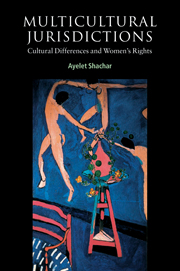Book contents
- Frontmatter
- Contents
- Preface
- 1 Introduction
- 2 The perils of multicultural accommodation
- 3 Family law and the construction of collective identity
- 4 State vs. nomos: lessons from contemporary law and normative theory
- 5 Sharing the pieces of jurisdictional authority: mapping the possibilities
- 6 Transformative accommodation: utilizing external protections to reduce internal restrictions
- 7 Conclusion
- Appendix: How transformative accommodation works in different social arenas
- References
- Index
Appendix: How transformative accommodation works in different social arenas
Published online by Cambridge University Press: 22 September 2009
- Frontmatter
- Contents
- Preface
- 1 Introduction
- 2 The perils of multicultural accommodation
- 3 Family law and the construction of collective identity
- 4 State vs. nomos: lessons from contemporary law and normative theory
- 5 Sharing the pieces of jurisdictional authority: mapping the possibilities
- 6 Transformative accommodation: utilizing external protections to reduce internal restrictions
- 7 Conclusion
- Appendix: How transformative accommodation works in different social arenas
- References
- Index
Summary
We have already seen what the necessary assumptions are for transformative accommodation to work and what the principles are by which it works. In this section we will discuss examples in three different social arenas where the principles introduced above will lead to (or have led to) a progressive transformation of the state and/or the nomoi group involved. The discussion will illustrate how this variant of joint governance can be applied in different social arenas which have become highly contested in the multicultural state, such as immigration, education, and criminal justice.
IMMIGRATION LAW
In immigration law, a basic division is made between the activities of “admission” and “selection.” Admission refers to the rules shaping the overall immigration policy of a given state in determining how many people can be admitted to a given country in a given year, and based on what considerations (family re-unification, humanitarian grounds, professional qualifications, etc.). Admission criteria also set the procedures to be followed, in order for someone outside the polity to apply for immigration status in it. Selection, meanwhile, is a complementary authority. It involves the administrative activity of selecting who will actually enter a given country as an immigrant within a given annual quota from a pool of applicants who must also fulfil the admission threshold. Each legal immigrant entering a country must have both qualified for admission, and been selected to enter the host country by an official of that country's immigration authorities.
- Type
- Chapter
- Information
- Multicultural JurisdictionsCultural Differences and Women's Rights, pp. 151 - 165Publisher: Cambridge University PressPrint publication year: 2001



